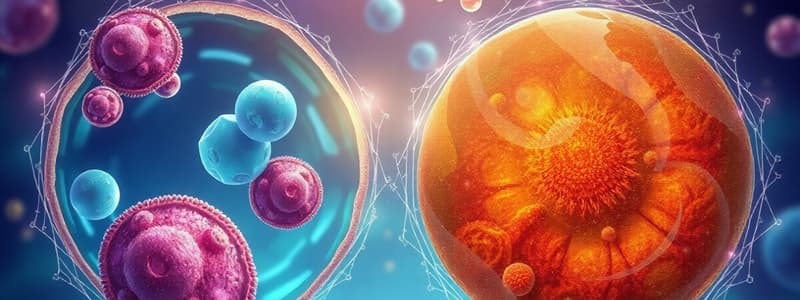Podcast
Questions and Answers
Eukaryotic cells are structurally and functionally less complex than prokaryotic cells.
Eukaryotic cells are structurally and functionally less complex than prokaryotic cells.
False (B)
Which of the following are similarities between animal and plant cells? (Select all that apply)
Which of the following are similarities between animal and plant cells? (Select all that apply)
- Endoplasmic Reticulum (ER) (correct)
- Nucleus (correct)
- Cytoplasm
- Cell Membrane (correct)
- Ribosomes
- Golgi Apparatus (correct)
- Mitochondria (correct)
- Lysosomes
Which of the following organelles is unique to plant cells?
Which of the following organelles is unique to plant cells?
- Vacuole
- Chloroplasts (correct)
- Centrioles
- Peroxisomes
- Cell Wall
What is the function of a cell wall in plant cells?
What is the function of a cell wall in plant cells?
Animal cells have a central vacuole that stores water, ions, nutrients, and waste products.
Animal cells have a central vacuole that stores water, ions, nutrients, and waste products.
Centrioles are involved in cell division in both animal and plant cells.
Centrioles are involved in cell division in both animal and plant cells.
What is the primary function of peroxisomes in animal cells?
What is the primary function of peroxisomes in animal cells?
What is the main difference between the cell membrane and plasma membrane?
What is the main difference between the cell membrane and plasma membrane?
The organization of a virus is similar to that of a living cell.
The organization of a virus is similar to that of a living cell.
What is the protein coat that surrounds the genetic material of a virus called?
What is the protein coat that surrounds the genetic material of a virus called?
What is the main difference between enveloped and non-enveloped viruses?
What is the main difference between enveloped and non-enveloped viruses?
Viral proteins are essential for host cell recognition, attachment, and entry.
Viral proteins are essential for host cell recognition, attachment, and entry.
Viruses can reproduce independently, without the help of host cells.
Viruses can reproduce independently, without the help of host cells.
The organization of a virus is essential for developing antiviral treatments and vaccines.
The organization of a virus is essential for developing antiviral treatments and vaccines.
Flashcards
Eukaryotic Cell
Eukaryotic Cell
Complex cells with membrane-bound organelles.
Cell Membrane
Cell Membrane
A protective barrier that regulates what enters and leaves the cell.
Nucleus
Nucleus
The control center of a eukaryotic cell containing DNA.
Cytoplasm
Cytoplasm
Signup and view all the flashcards
Endoplasmic Reticulum (ER)
Endoplasmic Reticulum (ER)
Signup and view all the flashcards
Golgi Apparatus
Golgi Apparatus
Signup and view all the flashcards
Mitochondria
Mitochondria
Signup and view all the flashcards
Lysosomes
Lysosomes
Signup and view all the flashcards
Cell Wall
Cell Wall
Signup and view all the flashcards
Chloroplasts
Chloroplasts
Signup and view all the flashcards
Vacuole
Vacuole
Signup and view all the flashcards
Centrioles
Centrioles
Signup and view all the flashcards
Peroxisomes
Peroxisomes
Signup and view all the flashcards
Prokaryotic Cell
Prokaryotic Cell
Signup and view all the flashcards
Virus Structure
Virus Structure
Signup and view all the flashcards
Genetic Material (Virus)
Genetic Material (Virus)
Signup and view all the flashcards
Capsid
Capsid
Signup and view all the flashcards
Envelope (Virus)
Envelope (Virus)
Signup and view all the flashcards
Viral Proteins
Viral Proteins
Signup and view all the flashcards
Eukaryotic vs Prokaryotic
Eukaryotic vs Prokaryotic
Signup and view all the flashcards
Animal vs Plant Cells
Animal vs Plant Cells
Signup and view all the flashcards
Photosynthesis
Photosynthesis
Signup and view all the flashcards
ATP
ATP
Signup and view all the flashcards
Membrane-bound Organelles
Membrane-bound Organelles
Signup and view all the flashcards
Lipid Bilayer
Lipid Bilayer
Signup and view all the flashcards
Cellular Machinery
Cellular Machinery
Signup and view all the flashcards
Virus Lifecycle
Virus Lifecycle
Signup and view all the flashcards
Antiviral Treatments
Antiviral Treatments
Signup and view all the flashcards
Study Notes
Eukaryotic Cell Organization
- Eukaryotic cells are more complex than prokaryotic cells
- They have membrane-bound organelles, performing specialized functions
- Eukaryotic cells (animals and plants) share common features due to a shared ancestry
- Key differences exist between animal and plant cells
Similarities between Animal and Plant Cells
- Cell membrane
- Nucleus
- Cytoplasm
- Endoplasmic reticulum (ER)
- Golgi apparatus
- Mitochondria
- Lysosomes (more common in animal cells)
- Ribosomes
Differences between Animal and Plant Cells
- Cell Wall: Plant cells have a rigid cell wall made of cellulose, providing support and protection. Animal cells lack this.
- Chloroplasts: Plant cells contain chloroplasts, sites of photosynthesis, converting light energy to chemical energy. Animal cells lack chloroplasts.
- Vacuole: Plant cells have a large central vacuole for storing water, ions, nutrients, and waste products, Animal cells may contain smaller, sometimes multiple vacuoles.
- Centrioles: Animal cells possess centrioles, involved in cell division. Plant cells lack centrioles.
- Peroxisomes: Both plant and animal cells contain peroxisomes. Their functions and numbers can vary between the two, with roles in fatty acid metabolism, detoxification, and bile acid synthesis (in animals); photorespiration, purine metabolism, and fatty acid metabolism in plants.
Eukaryotic Cell Structure (diagram)
- Diagram shows a plant cell (A) and an animal cell (B)
- Common features are labelled
- Differences are highlighted
- Plant cells may have lysosomes like structures called lytic vacuoles
- Microtubules and secretory vesicles also exist in plant cells
- Cell membrane and plasma membrane are the same structure
Comparison Table (Animal vs. Plant Cells)
- Cell Wall: Absent (animal), Present (plant)
- Shape: Variable (animal), Usually regular (plant)
- Vacuole: Small, numerous (animal), Large central (plant)
- Chloroplasts: Absent (animal), Present (plant)
- Lysosomes: Present (animal) but less common (plant)
- Centrioles: Present (animal), Absent (plant)
- Plasmodesmata: Present (plant), Absent (animal)
- Organelles Different functions in Animals and Plants
Comparison Table (Prokaryotic vs. Eukaryotic Cells)
- Type of Organism: Bacteria, Archaea (prokaryotic), Multicellular organisms (eukaryotic)
- DNA Structure: Single, circular chromosome (prokaryotic); Multiple linear chromosomes (eukaryotic)
- Nucleus: Absent (prokaryotic), Present (eukaryotic)
- Organelles: Absent (prokaryotic), Present (eukaryotic)
- Ribosomes: Smaller (70S) (prokaryotic), Larger (80S) (eukaryotic)
- Size: Smaller (1-5 μm) (prokaryotic), Larger (10-100 μm) (eukaryotic)
- Cell Wall: Present (many prokaryotic), Present/absent, different compositions (eukaryotic)
- Endoplasmic Reticulum: Absent (prokaryotic), Present (eukaryotic)
- Golgi Apparatus: Absent (prokaryotic), Present (eukaryotic)
- Mitochondria: Absent (prokaryotic), Present (eukaryotic)
- Chloroplasts: Absent (prokaryotic), Present (plants)
- Flagella/Cilia: Simple (prokaryotic), Complex (9+2 microtubule arrangement) (eukaryotic)
- Reproduction: Binary fission (prokaryotic), Mitosis/Meiosis (eukaryotic)
- Examples: Bacteria, Archaea (prokaryotic); Animals, Plants, Fungi, Protists (eukaryotic)
Viruses
- Simple structure compared to cells
- Lack cellular machinery (metabolism, energy production, replication)
- Rely on host cells for replication
- Genetic material (DNA or RNA)
- Capsid (protein coat)
- Some have an envelope (derived from host cell membrane)
- Viral proteins essential for infection process
Studying That Suits You
Use AI to generate personalized quizzes and flashcards to suit your learning preferences.



